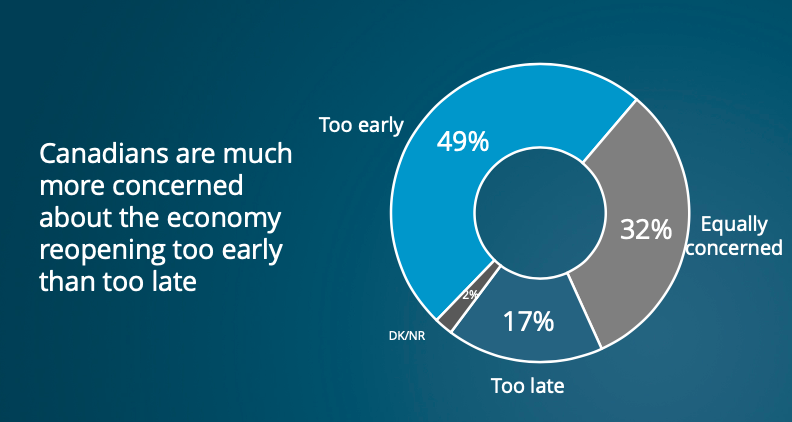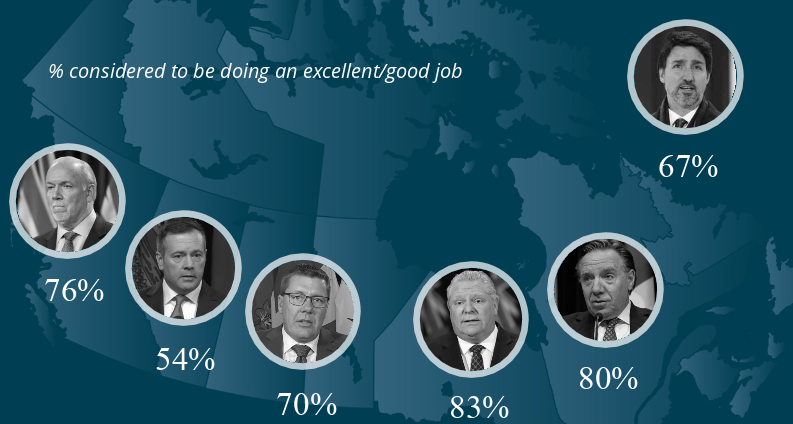Written by Doug Anderson, Allan Gregg and Stephanie Constable for Policy Magazine on May 28, 2020. Click here to read the original.
More than two months after Prime Minister Justin Trudeau began briefing Canadians daily on the COVID-19 coronavirus pandemic that has now killed thousands of Canadians, Earnscliffe Strategy Group can report on the mood of Canadians expressed in a recent national poll. As with many other studies, we found remarkably broad national consensus on a variety of subjects: the perceived severity of the pandemic crisis; how it has impacted Canadians; and, how the public is assessing the performance of frontline workers, public health officials, governments and leaders.
The survey was conducted online using Leger’s LEO panel from a sample of 1, 913 respondents from May 6-14.

While it is hardly surprising to find the high levels of appreciation we found for frontline workers and first responders, one rarely sees endorsement of political leaders far outstripping partisan support. A majority of Canadians say the prime minister is doing a good or excellent job of dealing with the pandemic and in every province, a majority say the same of their premier.
High levels of endorsement normally breed public trust and, with it, a healthy degree of latitude for determining the best course of action. We are in a moment where there is an alignment of a singular focus of concern, a partisan cease-fire, a deference to experts, and appreciated actions that are producing what might be termed “peak endorsement.” But where does it go from here? Like a sort of political entropy, the consensus has the potential to break apart and our study provides evidence of the kinds of fault lines that are most likely to return us to a more divided electorate.

In our survey, we gauged the support for 20 potential policies that might be considered to address the next phase of the pandemic as the country switches from containment to staging a long, slow return to normalcy.
In terms of mitigating health risks, strong majorities can get behind the idea of continuing the kinds of physical distancing measures to which we have all become accustomed, particularly as people return to workplaces or visit retail outlets. Although slightly lower, majorities also support the limitations of gatherings at sports or entertainment events and even at family occasions such as weddings or funerals. Perhaps reflecting a new open-mindedness to innovative policy responses, there is even significantly more support than opposition to introducing a guaranteed annual income or helping the battered energy sector by compensating companies for converting to producing renewable energy.
On the other end of the policy spectrum, there’s a fair degree of opposition consensus towards measures like dramatically raising taxes to pay for the stimulus spending during the pandemic or cancelling tax debts owed by medium and large businesses.

In between, we see a division of opinion on other responses that might be implemented during the re-opening, such as: initiatives that could be considered freedom-limiting such as banning unnecessary travel or even making it a crime to not get vaccinated; location tracking that might be considered privacy- infringing; and economic policies that could impact the role and size of government such as cancelling tax debts owed by individuals, putting an end to subsidies going to industries or nationalizing more companies.

While these results clearly show where there is a national consensus or not, they hide a deeper division that lies below the surface of nationwide public opinion — indeed, divisions in the public that can be leveraged and exploited by those with certain partisan or policy interests.
In fact, what we find is that the Canadian population is actually comprised of three equally-sized segments of opinion when it comes to support or opposition to this list of possible public policy responses:
- The Supportive (33 percent): These people have a tendency to support almost any and all of the policies tested, which is not surprising given that those Canadians who feel that the pandemic has had both a major impact on their lives and on
their finances are disproportionately in this segment. The size of this segment varies regionally, with a low of 26 percent in Saskatchewan and a high of 43 percent in Atlantic Canada. Liberal (42 percent) and NDP (39 percent) voters are most likely to be in this segment, but 27 percent of CPC voters are also found in this segment. Of the 20 measures tested, this segment only opposes the three least popular overall. A stakeholder, policymaker or political leader who wants to put forward any policy that doesn’t include a tax increase, or significant benefits for big business can probably count on this third of the population to be very receptive to hearing the pitch. - The Selective (35 percent): This group has strong net support for some measures, is divided over some, and has strong net opposition to others. They also make up about a third of the population in every region ranging from 32 percent in Quebec to 38 percent in Atlantic Canada. Similarly, they make up between 32 percent and 38 percent of every federal party’s voters from the 2019 election. They differ from the supportive segment in two important ways: first they are much more likely to oppose privacy-infringing measures such as contact testing and secondly, they are loath to see government spending or ownership expand. This is perhaps the segment that provides the greatest hints at the kind of wedging that might occur in the coming months. On limiting the size of gatherings or banning gatherings such as sporting events, they are perfectly aligned with the supportive segment with overwhelming net support. On location-tracking they are perfectly aligned with the opposed segment with overwhelming net opposition.
- The Opposed (32 percent): Notionally the “equal opposite” to the supportive segment, these people oppose almost all of the measures tested. They, too, can be found in every region, with proportions ranging from 19 percent in Atlantic Canada to 40 percent in Saskatchewan. Politically, CPC voters are most likely to be in this segment (41 percent) compared to only 24 percent of Liberal or NDP voters. They differ from the selective segment in two important ways: they are far more likely to oppose freedom-limiting measures such as the size of gatherings or “mandatory” initiatives like travel bans and wearing of masks. Notwithstanding their opposition to these policies, they are also net supportive in three areas: implementing strict workplace measures; introducing a guaranteed annual income; and, compensating energy companies that convert to producing renewable energy. Clearly, traditional partisan ideology is not the only factor at play with this cohort of the population.
Taken together, what the survey has demonstrated is that the next, re-opening, phase of governing will almost certainly be more difficult than the crisis management phase and undoubtedly will result in more divided opinions than we have seen thus far in the pandemic. A short list of measures, particularly those involving mitigation of personal health risks, can be implemented with relatively modest opposition, but beyond those, expect a return to a more vocal debate, especially if initiatives revolve around issues such as privacy and government reach.
Doug Anderson, a Principal of the Earnscliffe Strategy Group in Ottawa, is a public opinion specialist, largely focusing on public affairs and public policy issues. Stephanie Constable, also a principal of Earnscliffe in Ottawa, is a specialist in polling insights and communications advice, notably branding and advertising strategies. Allan Gregg is among Canada’s most recognized public opinion researchers and pollsters. A principal of Earnscliffe in Toronto, he now works primarily with consulting clients, associations and agencies.
